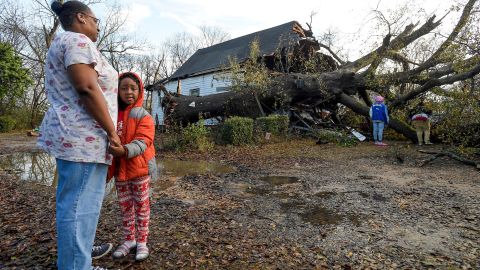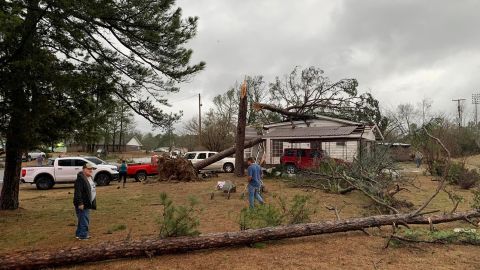CNN
—
Another powerful storm, known as a bomb cyclone, is hitting the California coast and the National Weather Service in the Bay Area is warning residents that the “truly brutal” system needs to be taken seriously.
The system could trigger “immediate disruption to commerce, and the worst of all, likely loss of human life,” forecasters say. It comes on the heels of the last round of record-breaking rainfall that slammed the same area over the weekend.
Meanwhile, a major winter storm that brought snow and freezing rain to its colder northern end – and severe storms and tornadoes on its warmer southern end – is still threatening more severe weather as it treks east.
California’s storm is prompted by a strong “atmospheric river” – a long, narrow region in the atmosphere that can carry moisture thousands of miles. Northern California and the Bay Area will see the worst impacts through the day Wednesday and Thursday as heavy rain and hurricane-force wind gusts move onshore.
The storm became a bomb cyclone Wednesday, after it rapidly strengthened while still offshore. A bomb cyclone is an area of low pressure that intensifies by 24 millibars within 24 hours. Millibars are a unit used to measure atmospheric pressure.
Watch: what is a bomb cyclone?
Along with very heavy rainfall, winds gusting as high as 60 to 80 mph will be possible.
“If these winds do materialize, the threat for scattered to widespread power outages and property damage will greatly increase,” the weather service office in San Francisco warned.
“A plethora of hazards are forecast, with heavy rain and strong winds expected to be the most widespread impact. Widespread rainfall amounts of 3 to 6 inches are anticipated, with locally higher amounts throughout the coastal ranges and over northern California,” the weather service said.
While those expected rainfall amounts wouldn’t normally have major impacts, the state recently saw heavy rain that left soil saturated and susceptible to flooding and landslides, the weather service said.
Northern California in particular was inundated with heavy snowfall and deadly flooding over the weekend, prompting evacuation orders and water rescues. That raised questions over how much the precipitation would put a dent in California’s ongoing drought conditions.
The first snow survey of the season in the Sierra Nevada Mountains released Tuesday shows the current snowpack is well ahead of average for this time of year, according to a release from the California Department of Water Resources.
The Sierra snowpack makes up about 30% of California’s water needs on average, according to the department.
The snow depth measured Tuesday at Phillips Station, just south of Lake Tahoe, was 55.5 inches. Statewide, the snowpack is at 174% of average for this date, the agency said.
However, experts caution that despite the deluge – and expected precipitation over the coming week – the drought isn’t over yet.
“The significant Sierra snowpack is good news but unfortunately these same storms are bringing flooding to parts of California,” DWR Director Karla Nemeth said in a news release.
“This is a prime example of the threat of extreme flooding during a prolonged drought as California experiences more swings between wet and dry periods brought on by our changing climate.”
And the stormy weather isn’t going to let up anytime soon. More rain is expected through the weekend, though the specific impacts aren’t clear yet.
“The message to convey is resiliency as this is not a ‘one and done’ storm,” the weather service in San Francisco said.
Meanwhile, more than 30 million people are under some sort of severe weather threat in the South, with the risk of severe storms stretching from the Florida Panhandle into far southeast Alabama and parts of Georgia and along the East Coast into southeastern Virginia.
As the showers and storms push into Georgia and northern Florida, damaging wind gusts, large hail and tornadoes are possible.
Cities including Tallahassee, Charlotte, Virginia Beach, Atlanta, Raleigh and Norfolk could see winds and tornadoes. Heavy rain could also produce flash flooding in parts of the Southeast.
The multi-hazard storm – which headed into the central and southern US after battering California with deadly floods – has already triggered at least 130 storm reports over the past two days and left a trail of destruction as it barreled across the country, shifting to the South and Southeast.
There have been at least a dozen reports, nearly 100 wind reports and 27 hail reports. The tornado reports included six in Illinois on Tuesday and an EF-1 in Jessieville, Arkansas, on Monday. An EF-1 tornado packs winds of 86 to 110 mph.
Other tornado reports came from Louisiana, Oklahoma, Tennessee, Georgia and Mississippi.

Police in Montgomery, Alabama, were dispatched throughout the night to “multiple locations” in the city in response to “reports of damage due to (a) possible tornado,” the city said Wednesday. It’s unclear how many structures were damaged.
A tornado watch stretches across portions of the Southeast from northern Florida to South Carolina until midday.
The storm also brought heavy rain, with much of the South seeing 48-hour rainfall totals between 2 to 4 inches. Some areas across the Mississippi and Ohio River Valley saw up to 6 inches, and isolated areas across eastern Arkansas got 10 inches.
In Tennessee, Memphis and Jackson both saw record-breaking rainfall on Tuesday. Memphis received 3.84 inches, smashing its previous daily record of 2.13 inches set in 1949. Jackson got 2.48 inches on Tuesday, beating the previous daily record of 1.69 inches in 1951.
An extremely warm and moist air mass over the East Coast and Southeast helped fuel the severe weather outbreak. Over 35 daily high temperature records were broken across the eastern US on Tuesday, with the thermometer hitting 81 degrees in Baton Rouge, 77 degrees in Wilmington and 69 degrees in Washington, DC.
Meanwhile, over 5 million people are under winter weather alerts across the Upper Midwest and Great Lakes, where snow and ice accumulations are expected to affect travel, according to the weather service.
Heavy snow is expected across parts of the Upper Midwest through Wednesday, while freezing rain and a wintry mix will spread into northern New England by Thursday, the weather service says.
The storm is expected to gradually begin dissipating Thursday.

Along with reports of tornadoes and powerful wind came news of damage. One of the tornadoes was reported in Jonesboro, Louisiana, where large trees were knocked down.
In Jessieville, Arkansas, a reported tornado damaged multiple buildings at a school along with several homes in the area, according to the Garland County Sheriff’s Office.
“The school was currently in session at the time, however all students have been accounted for and reports of no injury,” the Sheriff’s Office said in a release.
Images also showed toppled trees and home damage in other parts of Garland County.
Storm damage was also reported Tuesday in Marion, Alabama, where a home appeared to have been shifted off its foundation, CNN affiliate WBRC reported.
“The best thing is my husband and I are alive. Material things can be replaced but our lives cannot, and we just thank God that we are here,” homeowner Sylvia Hester told the station, standing alongside her husband next to their damaged home of two decades.
Damage reports were also coming from northern Louisiana, where several transmission towers were damaged in the Haile community in Marion. One of the towers was knocked over and several others are damaged, according to the National Weather Service in Shreveport.
In Jackson Parish, Louisiana, residents were told to stay off the roads Monday as the severe weather toppled trees and powerlines, and covered roadways with water.
In addition to tornadoes, some communities saw hail and powerful winds.
There were reports of hail Monday in Oklahoma, Texas and Louisiana – and in Mississippi, Louisiana, Illinois and Alabama on Tuesday.